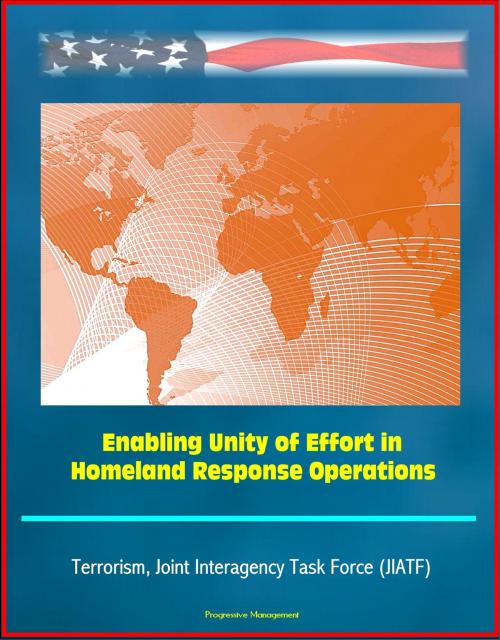Enabling Unity of Effort in Homeland Response Operations - Terrorism, Joint Interagency Task Force (JIATF)
Nonfiction, Social & Cultural Studies, Political Science| Author: | Progressive Management | ISBN: | 9781301906215 |
| Publisher: | Progressive Management | Publication: | March 5, 2013 |
| Imprint: | Smashwords Edition | Language: | English |
| Author: | Progressive Management |
| ISBN: | 9781301906215 |
| Publisher: | Progressive Management |
| Publication: | March 5, 2013 |
| Imprint: | Smashwords Edition |
| Language: | English |
Any significant homeland response event requires Americans to work together. This has proven to be a complex challenge. Our response capabilities, while substantial, are spread across thousands of stakeholders: federal, state, and local government agencies and organizations, nongovernmental organizations, and private industry. No single actor has all the necessary tools to respond completely to a major crisis. Despite considerable national effort and resources devoted to planning, training, integrating, and improving our homeland response capabilities, effectiveness in working together—unity of effort — still seems to elude us. Achieving unity of effort is difficult even in simple situations. It becomes increasingly complicated when it involves dozens or even hundreds of participants in a federal system such as ours, where responsibility and capability are distributed across many levels and functions. Finding ways to synergize a broad range of responsible participants is the central challenge to effective homeland response operations.
In this monograph, it is argued that the problem of achieving unity of effort in homeland response is not one of poor planning or inadequate resources, but rather more fundamental. It involves the way in which thousands of participants from dissimilar professional cultures think about their roles and responsibilities for homeland response. To address this problem, the authors propose a broadly construed national doctrine, developed in a dynamic and responsive doctrine-producing system. They cite the example of joint military doctrine, which attained its contemporary robust state and authoritative impact only through changes implemented as a result of the Goldwater-Nichols Act. The joint doctrine-producing system that arose from Goldwater-Nichols remedied many shortcomings, such as enforcing congruity between individual service and joint doctrine, identifying and addressing capability gaps, and incorporating the requirements of field commanders. The authors contend that a dynamic national homeland response doctrine, developed in a truly inclusive national system, would have a similar effect in synergizing national capabilities. They propose a doctrinal system that develops and implements operational concepts, plans, and training programs. The concepts are thoroughly tested in realistic exercises and actual operations. The plans, operations, and training programs are then systematically analyzed to inform and update evolving doctrinal concepts, which ultimately influence the organization, training, and equipping of response elements.
The authors contend that such a national doctrine requires a new management concept, fashioned on the model of the military's Joint Interagency Task Force (JIATF). They argue that this concept has broad potential not just in support of military operations, but any time disparate response organizations must work together. They suggest a JIATF-like inter-agency coordination and action group which could operate across and between jurisdictional divides to unify not just the federal interagency response, but state and perhaps local interagency efforts as well. In developing this idea, they outline some of the critical functions this element should perform.
Finally, the authors address the problem of ensuring that our military's available "dual capable" forces—active and reserve—are contributing to unity of effort in homeland response. They discuss the nascent potential of dual-status command, the artificial impediment posed by the division of forces into separate legal statuses under Title 10 and Title 32, and the possibility of a civil support force generation model to improve predictability in providing available capabilities for homeland response.
Any significant homeland response event requires Americans to work together. This has proven to be a complex challenge. Our response capabilities, while substantial, are spread across thousands of stakeholders: federal, state, and local government agencies and organizations, nongovernmental organizations, and private industry. No single actor has all the necessary tools to respond completely to a major crisis. Despite considerable national effort and resources devoted to planning, training, integrating, and improving our homeland response capabilities, effectiveness in working together—unity of effort — still seems to elude us. Achieving unity of effort is difficult even in simple situations. It becomes increasingly complicated when it involves dozens or even hundreds of participants in a federal system such as ours, where responsibility and capability are distributed across many levels and functions. Finding ways to synergize a broad range of responsible participants is the central challenge to effective homeland response operations.
In this monograph, it is argued that the problem of achieving unity of effort in homeland response is not one of poor planning or inadequate resources, but rather more fundamental. It involves the way in which thousands of participants from dissimilar professional cultures think about their roles and responsibilities for homeland response. To address this problem, the authors propose a broadly construed national doctrine, developed in a dynamic and responsive doctrine-producing system. They cite the example of joint military doctrine, which attained its contemporary robust state and authoritative impact only through changes implemented as a result of the Goldwater-Nichols Act. The joint doctrine-producing system that arose from Goldwater-Nichols remedied many shortcomings, such as enforcing congruity between individual service and joint doctrine, identifying and addressing capability gaps, and incorporating the requirements of field commanders. The authors contend that a dynamic national homeland response doctrine, developed in a truly inclusive national system, would have a similar effect in synergizing national capabilities. They propose a doctrinal system that develops and implements operational concepts, plans, and training programs. The concepts are thoroughly tested in realistic exercises and actual operations. The plans, operations, and training programs are then systematically analyzed to inform and update evolving doctrinal concepts, which ultimately influence the organization, training, and equipping of response elements.
The authors contend that such a national doctrine requires a new management concept, fashioned on the model of the military's Joint Interagency Task Force (JIATF). They argue that this concept has broad potential not just in support of military operations, but any time disparate response organizations must work together. They suggest a JIATF-like inter-agency coordination and action group which could operate across and between jurisdictional divides to unify not just the federal interagency response, but state and perhaps local interagency efforts as well. In developing this idea, they outline some of the critical functions this element should perform.
Finally, the authors address the problem of ensuring that our military's available "dual capable" forces—active and reserve—are contributing to unity of effort in homeland response. They discuss the nascent potential of dual-status command, the artificial impediment posed by the division of forces into separate legal statuses under Title 10 and Title 32, and the possibility of a civil support force generation model to improve predictability in providing available capabilities for homeland response.















